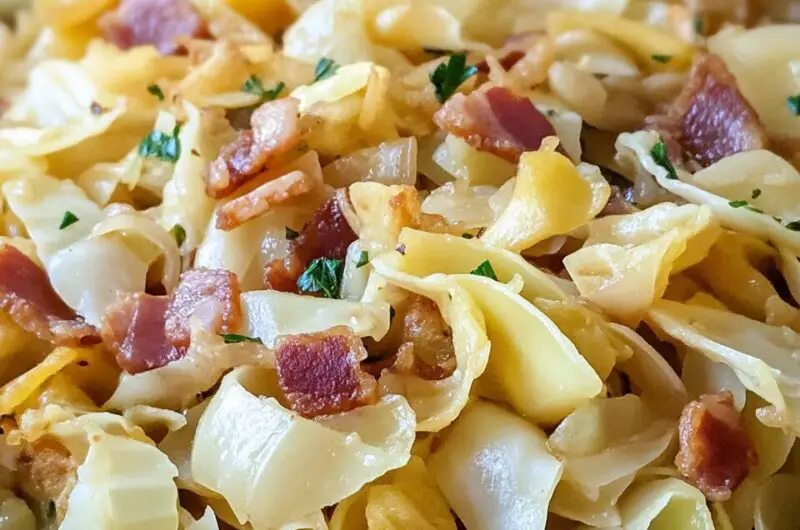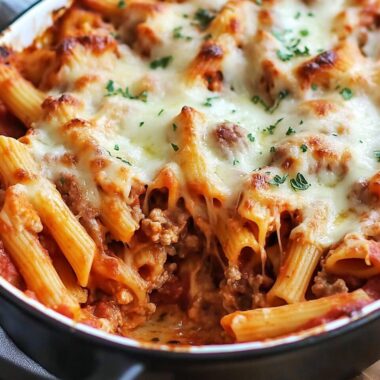The smell of buttery cabbage gently caramelizing in a hot skillet brings instant nostalgia to the kitchen. Haluski, a simple Eastern European dish made from tender egg noodles and slow-fried cabbage, is the kind of recipe that warms your soul and fills your belly without breaking the bank. It’s perfect for meatless nights or as a side dish with sausage or roast meats. This version gets a rich flavor from slow-sautéed onions and butter, blending beautifully with the tender sweetness of cabbage. A sprinkle of crispy bacon or a dash of parsley gives it that finishing touch that makes it feel home-cooked and loved.
Full Recipe:
Ingredients:
-
1 small head green cabbage, cored and sliced thin
-
1 large yellow onion, sliced thin
-
1 stick (1/2 cup) unsalted butter
-
Salt and pepper to taste
-
12 ounces egg noodles
-
Optional: crispy bacon bits or sautéed kielbasa slices for garnish
-
Optional: fresh parsley for garnish
Directions:
-
In a large skillet or Dutch oven, melt butter over medium heat.
-
Add the sliced cabbage and onion to the skillet. Cook slowly, stirring frequently, for about 25–30 minutes or until the cabbage is golden and tender. Season with salt and pepper.
-
Meanwhile, bring a large pot of salted water to a boil and cook egg noodles according to package directions. Drain well.
-
Add cooked noodles to the cabbage mixture and stir to combine. Adjust seasoning as needed.
-
Cook together for another 5 minutes to let the flavors meld.
-
Serve hot, optionally garnished with crispy bacon bits, sautéed kielbasa, or chopped parsley.
Prep Time: 10 minutes | Cooking Time: 35 minutes | Total Time: 45 minutes
Kcal: 365 kcal | Servings: 6 servings
A Deep Dive into Haluski – The Comfort Food Classic of Eastern Europe
Haluski a humble dish of fried cabbage and noodles has found its way into kitchens and hearts across the world. What was once a simple peasant meal in the heartlands of Eastern Europe has now become a beloved comfort dish for many, from heritage-rich Slavic households to modern foodies discovering traditional recipes. Though deceptively simple, Haluski is more than just cabbage and noodles. It’s a dish steeped in tradition, nostalgia, and timeless flavors.
In this article, we’ll explore the origins of Haluski, its cultural relevance, tips for perfecting the dish, delicious variations, and why it continues to stand the test of time. Whether you’re a long-time lover of this recipe or just discovering it for the first time, this article will give you a deeper appreciation of what makes Haluski so special.
The Humble Origins of Haluski
Haluski (pronounced “ha-loosh-key”) is a dish that originated in Central and Eastern Europe, particularly in countries like Poland, Slovakia, Ukraine, and Hungary. The name and specific preparation may vary slightly by region, but the base ingredients cabbage, onions, noodles, and butter or fat remain consistent. Historically, this dish was crafted by peasants and working-class families who relied on simple, affordable, and accessible ingredients to create hearty, satisfying meals.
Cabbage was a staple in these regions due to its affordability, long shelf life, and versatility. Combined with homemade egg noodles or dumplings (in some regions), and cooked in animal fats or butter, Haluski became a staple dish that offered both nutrition and comfort during the colder months.
A Beloved Tradition in the U.S.
As Eastern European immigrants settled in parts of the United States particularly in Pennsylvania, Ohio, and other parts of the Midwest they brought their culinary traditions with them. Haluski quickly became a popular dish in many American households, especially in regions known for their Polish, Slovak, or Ukrainian communities.
In these areas, you’ll find Haluski served at church picnics, heritage festivals, and holiday dinners. It’s especially common during Lent as a meatless main dish, though variations with bacon or kielbasa are also popular. What’s beautiful about Haluski is its adaptability. It can be dressed up or down, depending on what’s available in your kitchen or what you’re craving.
The Allure of Simplicity
One of Haluski’s enduring strengths is its simplicity. In an age where gourmet recipes often call for dozens of obscure ingredients, Haluski keeps things beautifully basic. With just a handful of items, you can create something deeply comforting and soul-satisfying.
The sweetness of slowly caramelized cabbage, the rich aroma of sautéed onions, and the soft chew of egg noodles all come together in perfect harmony. Butter acts as the unifier, coating each strand and slice in savory flavor. When cooked patiently, the dish achieves an almost creamy consistency without any actual cream just the right technique and a little bit of love.
Tips for the Perfect Haluski
While Haluski is easy to make, a few pro tips can elevate your dish from good to unforgettable:
1. Take Your Time with the Cabbage
The key to developing deep flavor in Haluski lies in the slow caramelization of the cabbage and onions. Don’t rush this step. Allow the vegetables to sweat and then brown slowly. This creates a natural sweetness that balances the savory richness of the noodles and butter.
2. Don’t Skimp on Butter
Traditionally, butter or rendered bacon fat is used generously in Haluski. While modern health-conscious cooks may want to reduce the fat content, the richness of the dish relies on a good amount of butter. Using a high-quality unsalted butter makes a noticeable difference.
3. Choose the Right Noodles
Egg noodles are classic, particularly the broad, ribbon-style noodles. However, in some regions, dumpling-style noodles or even spaetzle are used. The texture of the noodles should be soft but with a slight chew to stand up to the hearty cabbage mixture.
4. Season Boldly
Cabbage can be bland without proper seasoning. Generous use of salt and freshly cracked black pepper will bring the dish to life. A pinch of garlic powder or smoked paprika can add depth if you want to modernize it slightly.
Variations Worth Exploring
Though traditional Haluski is vegetarian and simple, variations abound. Here are a few popular ways people adapt the dish to suit different tastes:
1. With Bacon or Kielbasa
Adding crispy bacon bits or slices of smoked kielbasa adds a smoky, meaty depth that transforms Haluski into a hearty main dish. This version is especially popular in Americanized recipes.
2. With Dumplings or Homemade Pasta
In some Slovak or Hungarian renditions, instead of noodles, small potato dumplings (similar to gnocchi) or hand-cut pasta pieces are used. This creates a denser, even heartier version of the dish.
3. Vegan or Dairy-Free Haluski
Substitute butter with olive oil or a plant-based butter alternative. The dish still retains much of its flavor, especially if you caramelize the onions and cabbage properly.
4. With Vegetables or Sauerkraut
Some cooks add mushrooms, shredded carrots, or even sauerkraut to change the flavor profile. Sauerkraut adds a tangy twist that pairs well with the sweetness of caramelized onions.
Nutritional Considerations
Haluski may not be the lowest-calorie dish, but it provides a good balance of carbohydrates, fiber, and fats. The cabbage is rich in vitamins C and K, and if you prepare it with whole-grain noodles or add lean proteins, it becomes a well-rounded meal. For those on a budget or needing a pantry-friendly dish, Haluski ticks all the boxes it’s affordable, filling, and made with ingredients you likely already have.
Advertisement
Why Haluski Is the Ultimate Comfort Food
There’s a reason why Haluski has endured for generations. It speaks to something universal the desire for warmth, comfort, and nourishment. In many households, it’s a memory-laden dish, tied to grandmothers’ kitchens, family gatherings, or cozy winter nights.
The dish isn’t flashy. It doesn’t need exotic spices or fancy plating. But it delivers on flavor, satisfaction, and that ineffable feeling of being “home.” In a world where food trends come and go, Haluski remains a constant, a reminder of the beauty of simplicity done right.
Conclusion:
Haluski is a dish that proves the power of humble ingredients and patient cooking. With roots in Eastern Europe and a cherished place in many American kitchens, it’s a meal that unites generations and cultures through its satisfying warmth.
Whether you’re making it for the first time or continuing a family tradition, Haluski is more than a recipe it’s an experience. The scent of cabbage frying in butter, the soft texture of noodles, and the nostalgic comfort it brings to the table make this dish a timeless treasure worth celebrating.








